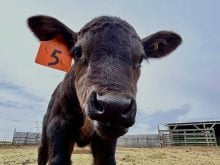Canadian beef production for the 2021 calendar year was estimated at 3.258 million tonnes, up seven per cent from the 2020 output of 3.057 million tonnes. U.S. commercial beef production was estimated at 27.950 billion pounds, which is a record high. This is up three per cent from the 2020 U.S. production of 27.174 billion pounds.
The year-over-year increase in beef production was met with stronger demand. The onset of vaccinations in February of 2021 caused wholesale values to reach record highs. As of mid-January, wholesale beef prices were US$50/cwt above year-ago levels. The 2021 calendar year will be remembered for historically high beef production and record-high wholesale and beef prices.
Read Also

Harvest wraps up and fall work begins
At the Eppich famly ranch in western Saskatchewan, the fall harvest was successful with few breakdowns, cows and calves have been sorted and a new tractor has arrived
The U.S. cattle herd has been in a contraction mode since 2018. However, the 2022 calendar year will be the first year-over-year decline in U.S. beef production since 2015. We’re looking for a year-over-year decline in the cow slaughter and increased heifer retention, especially in the latter half of 2022. From 2017 through 2020, the Canadian calf crop was hovering in the range of 4.3 to 4.4 million head. We’ll likely see a year-over-year decline in the Canadian calf crop on Statistics Canada’s Jan. 1 cattle inventory report.
The Omicron variant is causing a temporary decrease in beef movement. This has enhanced the seasonal slowdown in beef consumption during January. Everyone tries to lose five pounds after the holiday season.
Alberta packers were buying fed cattle in the range of $160-$162 FOB the feedlot in early January. This is down $4 to $6 from price levels during mid-December. Live prices in Texas and Kansas were quoted at $134-$137 in mid-January, down from the December average of $140. There appears to be a backlog of market-ready supplies of fed cattle in Western Canada. Fed cattle supplies are tighter south of the border but the slaughter pace is coming in lower than anticipated.
Feeder market remains strong
The feeder market has been a beacon of light early in 2022. During the first week of January, larger-frame, medium- to lower-flesh black mixed steers weighing just over 900 pounds were quoted at $201 in south-central Saskatchewan. Mixed steers weighing 875 pounds were valued at $197 in the Red Deer region. This is up $10 to $15 from early December. Calf prices have been pulled higher by the yearling market. Charolais steers on full health program that were weaned earlier in fall coming off silage and light grain ration averaging 650 pounds were reported at $208 in central Alberta. Similar-quality heifers weighing 610 pounds were valued at $184 in the same region. In central Saskatchewan, black mixed steers weighing just over 500 pounds reached $240 and similar-quality heifers averaging 505 pounds were quoted at $201.
During the 2021 calendar year, Canadian exports of feeder steers and calves to the U.S. were up 22 per cent from 2020. U.S. prices have been trading at a sharp premium to Canadian values. For example, in Green City, Missouri, a group of 530-pound steer calves sold for US$214.25 or C$272. In Dodge City, Kansas, a group of 815-pound steers sold for US$166 or C$210 in early January. We’re looking for a sharp year-over-year increase in Canadian feeder cattle exports during the 2022 calendar year.
Calf crop head count
The U.S. calf crop during the 2021 calendar year is expected to come in at 34.6 million head on the upcoming USDA cattle inventory report. This would be down from the 2020 calf crop of 35.1 million head and down from the 2018 high of 36.3 million head. Compare to 2019, the U.S. will have approximately 1.7 million fewer calves in 2022. The Canadian calf crop during 2021 will likely come in at 4.3 million head, down only 45,000 head from the 2020 calf output.
Again, as of mid-January feeder cattle futures were trading at US$166 while the October feeder cattle futures were at US$182. There is a $16 carry reflected in the feeder cattle futures. Compared to current prices in January, yearlings and calves in Western Canada will be approximately $20 higher in October. The market will encourage heifer retention on both sides of the border. This could result in approximately 500,000 head of heifers coming out of the feeder cattle pool in the U.S. and about 50,00-100,000 head of heifers in Western Canada. When heifer retention is at the peak, we usually see the feeder market surge. This sudden spike in the feeder market could also enhance the price structure if the feed grain supply in Western Canada normalizes. This is something to keep in mind next fall.
The fed cattle market will likely be a bit softer during the winter period. However, the backlog of market supplies will likely be cleaned up by early April. Canadian fed cattle prices will likely trade at a premium to U.S. values during the spring timeframe. The feeder market is expected to slowly trend higher over the next four to six-month period. Strength in the U.S. market will set the price structure in Western Canada given the year-over-year increase in feeder cattle exports.
Watch out for a spike in feeder prices next fall if heifer retention occurs as expected.
















